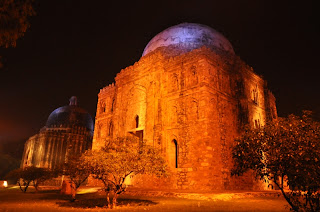Location - Kotla Mubarakpur
Co-ordinates - NA (alleys too narrow for a GPS signal)
Closest Metro Station - Lajpat Nagar (Purple Line)
Landmark - Opp Defence Colony
I started at a little before 8. It was a Saturday, not many people were around. As I crossed the road to Kotla Mubarakpur, it felt like crossing a few centuries. From the wide open posh Defence Colony to the cluttered medivial village of Kotla Mubarakpur is a change that can inspire anyone to say this. One moment, its B block, House no 28 in Defence Colony and a 2 minute walk across the road, there is an old settlement easy to get lost in. Houses hug each other closely, the roofs almost touch together, light barely gets in. From Honda Accords to good old bicycles, from stores selling olive oil to shops selling oily bread pakoras, the transformation does not take a minute.
 |
| Transported to the past |
As I walked into the narrow alleys, it was not difficult to realize I was lost. Each street looked like the other. After 2 turns, all sense of direction was lost. India is a land of uncertainities. Ask for directions from 10 people and I can bet an arm on it, you will get 10 answers. I asked people for old 'gumbads' (Gumbad is Urdu/Hindi for tombs). 'There are none around', 'What does that mean?', 'You should go to Red Fort', 'Its just around the corner' were amongst the responses I elicited. After multiple attempts, many failings, getting lost a few times, someone told me I needed to find the mosque. With an SLR slung around the neck and a small backpack across the back, I was already getting some weird looks. In due time, I found something. It was everything I had not expected.
 |
| Tomb of Mubarak Shah crisscrossed by electricity wires |
Staring at me was an octagonal tomb. Quite large, the size was accentuated by the closed surroundings. Surrounded by an iron railing and rounded by a 10 feet wide road, the claustrophobic surroundings made it look much bigger than it was. All around were myriad shops, a cobbler, a laundry, a general store. Trash was littered around. Atop the building was a lantern structure with pigeons flitting around.
 |
| Pigeons Flit around the top of the tomb |
The front gate was crudely locked with a bolt and screw. I enquired around and was told the local cobbler is the caretaker. After I had circled the building twice, a boy approached me. 'Do you want to get in?' he asked me. 'Yes'. 'Use the side gate'. He led me through the side gate and I was in the verandah. The boy looked about 15. His name was Aman. Over the next 30 minutes as I walked around the tomb, I bombarded him with questions and he answered patiently. The 'Tomb of Mubarak Shah' is locally known as Bada Gumbad (large dome). The locals say it houses the remains of a Sufi and his family. The largest grave is said to belong to the Sufi (unnamed) and the rest to his disciples/family.
 |
| Graves in the Tomb |
|
Cats and pigeons inhabit the Lodhi period tomb. By my guess, at anytime, it has 5 feline inmates and about 10 flying. Octagonal in shape, as is typical of Lodhi period tombs, the inside has intricate engravings all around. Three sides of the tomb have arched gateways while the one on the west is fashioned as a mihrab for a praying mosque with verses from Quran engraved on rock.
 |
| The Mihrab of the tomb with the engravings on top right and left |
|
|
The roof on the inside and the western face on the outside also have ornate carvings. Floral patterns or verses from the Quran are the most common. The roof has remains of the famed blue tile work. Though soiled by time, it still retains some of the original colour.
 |
| Carvings on the roof |
 |
| Carvings on the outside western face (on the outside of the prayer face) |
Unlike most other monuments that one gets to see around Delhi, this is a live monument. Everyday, people from all faiths come to the tomb, leave their footwear outside, walkin into to sanctum sanctorum and ask the Sufi for help with worldly matters. The multi-communal aspect of the monument is best highlighted by the half broken small idol of Ganesha displayed on South East face of the monument. As I was walking around the monument, I saw many a passer by pay their respects to the idol and I would guess, in turn to the Sufi as well.
 |
| The broken Ganesha idol on the South East face |
From the
Dadi Poti Maqbaras to Kotla Mubarakpur was quite a change. Both places have tombs from Lodhi period. One set is right opposite a posh market, is lighted by ASI, is fairly well maintained and is only visited by camera holding tourists, almost bearing an eerie, far away look. On the other hand is this quaint, large tomb in a quaint, medivial village, surrounded by walls on all sides, littered by pigeon and cat poop and still has enough significance for Aman to tell me to not worry about my footwear left outside. 'Bahar chhod dijiye, yahan se koi nahin le jayega' - Leave your footwear outside and dont bother, no one will steal from here (that is from a Sufi's tomb where people come to pray).
 |
| Offerings on one of the graves |
 |
| Aman, my informal guide for the morning |
For more, read the wikipedia link
here and references section.






























